

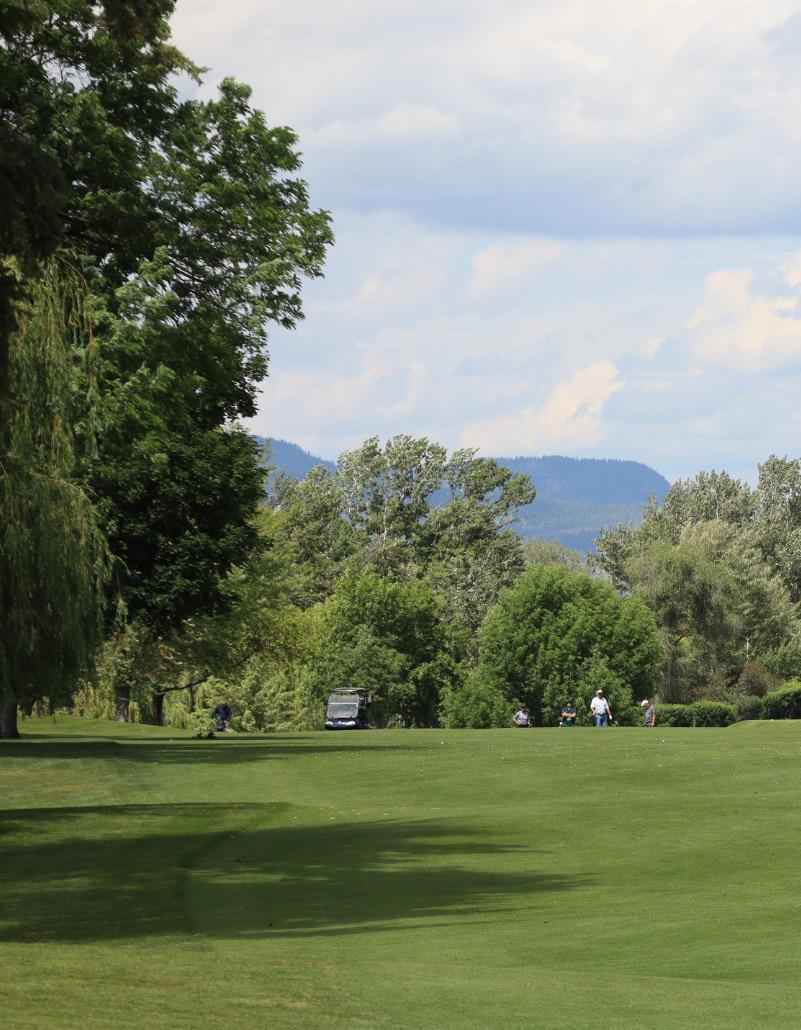




That’s a Wrap… (For Score Posting in Montana for 2025)
As the final leaves drop and Montana’s courses descend quietly into winter, the active golf season in Montana (April 1 - October 31) officially comes to a close. For most of us, that also means the end of the GHIN score-posting season in Montana. With this annual marker, it’s a fitting time to pause, look back on the rounds that shaped our season and take inventory of what comes next in our individual and collective golf journey.
Montana’s golf window is a narrow, but special one. Our long winters and short summers make every playable day feel precious. Whether you logged fifty rounds or fifteen, the rhythm of the season tells its own story: the familiar feel of the spring turf in April, the mid-summer form when everything feels smooth, and those crisp fall days when you wish the light would linger just a little longer to get those last holes of your twilight round in.
Your GHIN record is more than a list of scores — it’s a snapshot of your year in golf. The USGA’s GHIN Rewind will be sent to you all and does a phenomenal job of summarizing the statistics of the past year in a shareable form with your golf friends. We don’t have to wait for that to have a look at the year that was, so I’d recommend taking a peek at the season that was.
Open up your GHIN App (or maybe download it free from the App Store if you haven’t) and let’s dive into some of the nuggets you may or may not be aware of.

Did your scoring average improve? Were you more consistent? Best score? Worst score? Did you play more frequently or at new courses? All these answers are contained here.
The score history default shows your “Recent & Revision Scores.” These scores are used to calculate your current handicap.
Click the down arrow and you’ll be able to look at the entire year including any scores posted outside Montana’s active window. For example, I borrowed some rental clubs and played in Oregon in some very stereotypical Pacific Northwest weather back in March where score posting is in-season.
You’ll see the number of scores, high, low and average. Remember that your handicap is not your average. It represents your playing ability.
I was a little bit shocked to see that my scoring average was exactly the same in 2025 as 2024 despite more posting and more unrealistic aspirations. My high was lower, my low was the same and I did reach a couple personal

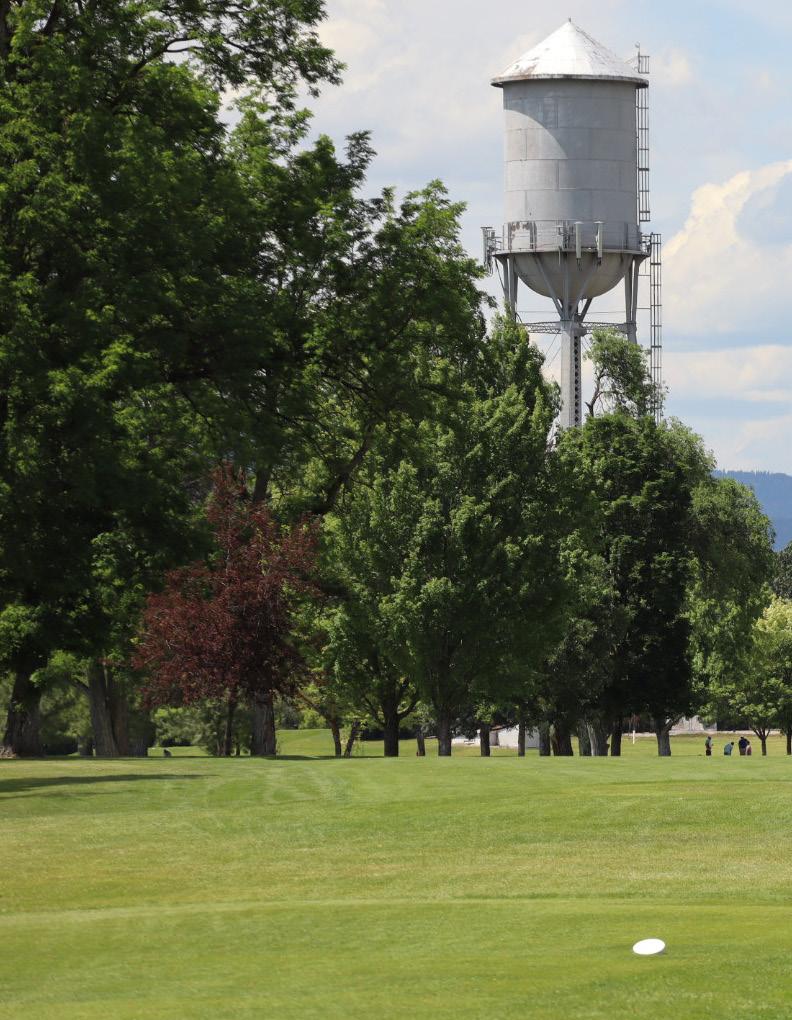

goals of playing more and playing more courses.
Next, the Stats tab is very instructive if you utilize the hole-by-hole score posting option. Personally, it takes longer, but I enjoy looking at trends in my game via some basic areas including: Scoring summary where I learned that I make 3x as many bogeys as birdies, avoid the big numbers fairly well and play par 5s better than 4s and 3s as one might expect. The advanced stats area taught me that my putting was slightly better than last year and I got up and down at a higher clip – aided by the fact that I missed more greens (sigh). My approach shot accuracy numbers taught me that I’m coming up short more often this year and missing left more than right compared to last year. I also hit the fairway more last year and missed left more – there is a trend here.
4 - 406GOLF - NOVEMBER 1, 2025

Sometimes it mirrors what I think or recall, but it’s helpful to have some evidence to back me up. Maybe next year I’ll take one more club and favor the right side. Obviously, this is overly simplistic, but it’s nice to know that these tidbits are available to all of us with the help of a smartphone.
Every golfer, from novice to scratch, benefits from looking back with honest eyes and a bit of grace.
Before the snow settles in, consider what your 2025 season taught you. Start with the basics:
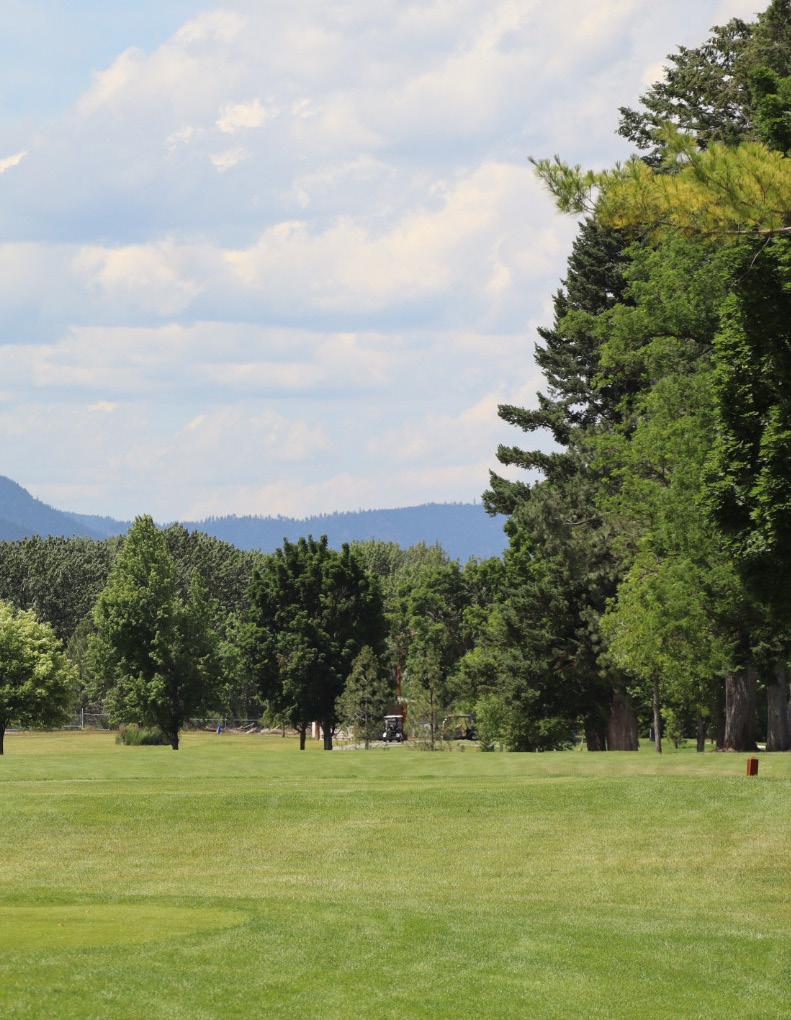
Technical: Which part(s) of your game needs attention? Driving accuracy, short game touch, putting confidence?
Physical: Could your endurance, flexibility, or balance use some work during the off-season?
Mental: How did you handle pressure, failure and even success? Not every golfer is competing, so let’s not get hung up on this too much, but we all want to see what we’re capable of and usually, a little pressure can reveal some things more clearly for better and worse. Don’t get too upset, there will be more opportunities. Don’t get too cocky, it’s golf, your successes won’t remain without continued play.
Equipment: Are your grips worn, wedge grooves a little rugged, or shafts still a good

fit? Do you have a gap in your set or would you benefit from another hybrid?
This kind of self-assessment turns the end of the year into a launching pad, not a letdown. Golf rewards those who stay curious about improvement.
The MSGA team did some golf goal setting (read on for more of that) reflection leads naturally to planning. The off-season is the perfect time to set specific, measurable goals for next year. Maybe you want to improve by two on your Handicap Index, play in an MSGA championship, or simply find more courses to play. Write those goals down. Then, think

about what it will take to achieve them — winter swing work at the local simulator, lessons from your local PGA professional, or a fitness routine focused on strength and mobility.
Many courses now have simulators available and some commercial outlets also offer these off-season swing areas. If not, putting drills on carpet or short-game work in a garage can go a long way. And remember, preparation isn’t only physical — review the Rules of Golf, follow MSGA updates, or explore volunteer opportunities that keep you connected to the game all year long.
What makes Montana golf unique isn’t just the scenery — it’s the people. We play through unpredictable weather, long drives between courses, and a season that always feels too short. But in that challenge lies the beauty: each round carries a sense of gratitude. Furthermore, if you’re lucky enough to get a golf trip during the winter months or you are a snowbird, relish those opportunities and invite a friend along or see if you can join a simulator league at your home club.
As many of your GHIN records pause for winter, the love of the game doesn’t. The friendships and memories you built this season continue to shape your connection to golf in the months ahead. Take pride in the year that was, and look forward to another chance — come April — to write the next chapter in your golfing story. We are thankful to play a small part of it.
Until then, remember that even when the scores stop counting, the spirit of the Montana Golf Community never takes a day off – stay connected with us and if you want, drop us a line to let us know about your highlight of the season or something you’re looking forward to next season.

BOARD OF DIRECTORS - OFFICERS
PRESIDENT................................................... Peter Benson
VICE PRESIDENT.................................. Ron Ramsbacher
TREASURER....................................................... Bill Dunn
PAST PRESIDENT......................................... Mary Bryson
EXEC COMMITTEE......................................Joe Rossman
BOARD OF DIRECTORS
Ross Bartell, Peter Benson, Carla Berg, Marshall Bettandorf, Mary Bryson, Brandon Davidson, Bill Dunn, Cheri Ellis, Lisa Forsberg, Marcia Hafner, Susan Haskins, Jeri Heard, Katy Peterson, Ron Ramsbacher, Karen Rice, Joe Rossman, Rod Stirling
MSGA STAFF
Executive Director......................................... Nick Dietzen
Tournament Director...................................... Tim Bakker
Membership Operations Director............... Emily Hulsey
Member Services Coordinator......................... Ian Hulsey
Communications & Tournament Manager.... Katie Fagg
Communcations Coordinator.......................... Ty Sparing
Partnerships & Business Development...... Nick Dietzen
USGA PJ Boatwright, Jr. Intern................ Dean Hendrix
USGA PJ Boatwright, Jr. Intern...................... Ella Prigge
USGA PJ Boatwright, Jr. Intern................ Stella Claridge
PARTNERSHIPS
Nick Dietzen.............................. 1 (800) 628-3752, ext. 6
406GOLF
Editor in Chief............................................... Nick Dietzen
Consulting Editor........................................ David Bataller
Senior Writer..................................................... Ty Sparing
Graphic Designer............................................... Katie Fagg
Contributing Writer...........................................Ella Prigge
Contributing Writer.....................................Dean Hendrix
Contributing Writer.........................................Bruce Scott
Contributing Writer.................Logan Groeneveld-Meijer
Contributing Writer..................................... Ross Niewola


Montana State Golf Association P.O. Box 4306 Helena, MT 59604
1 (800) 628-3752
www.msgagolf.org


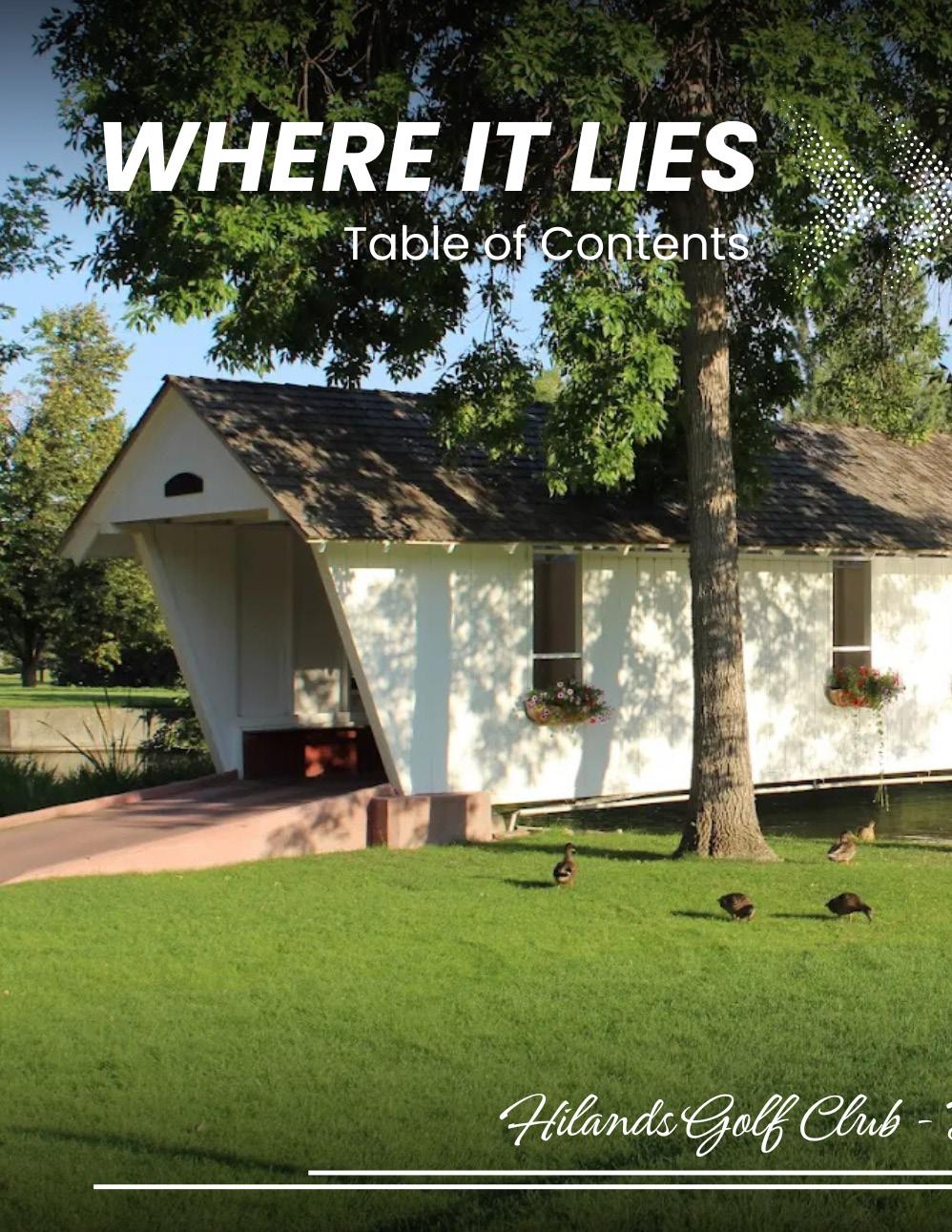
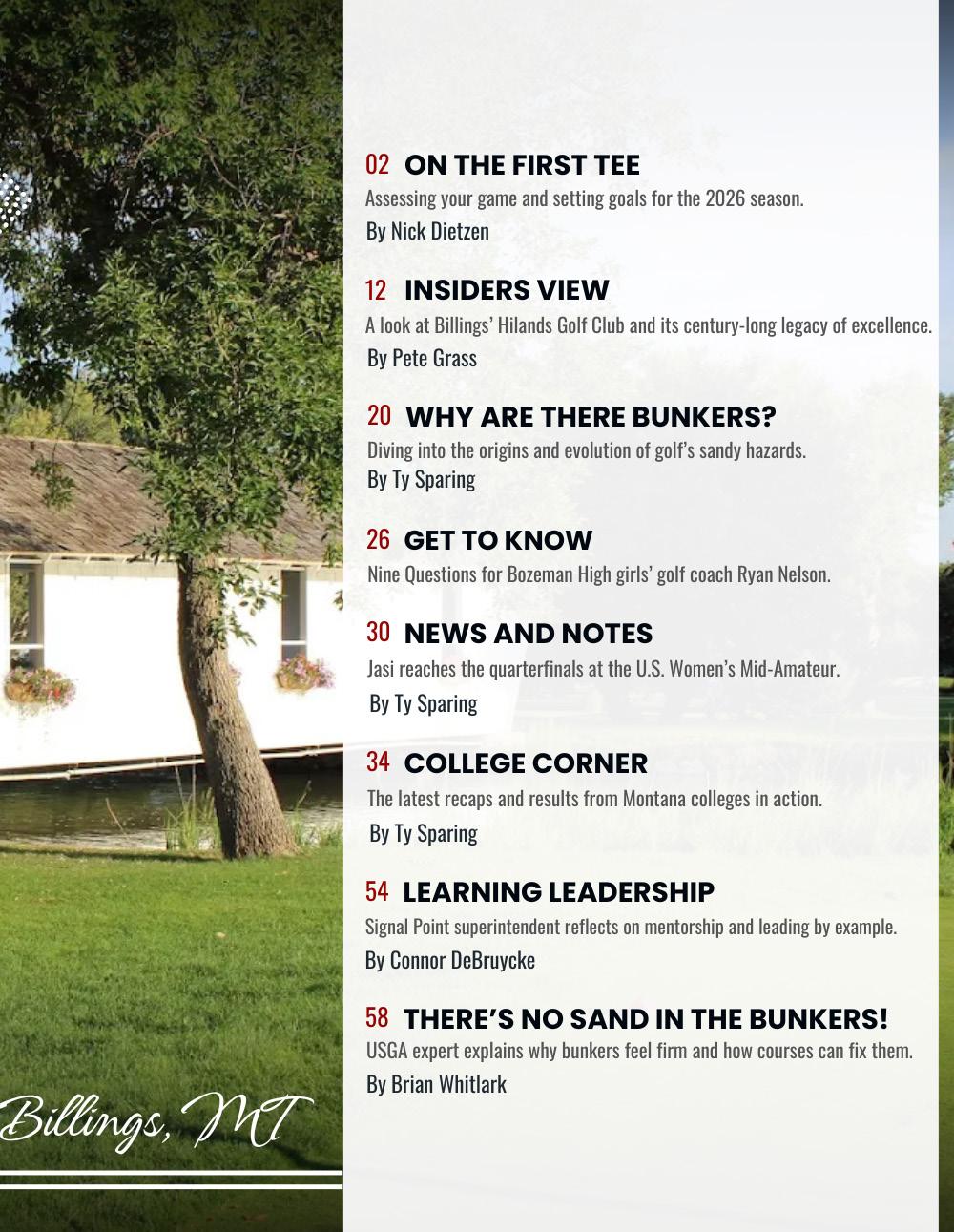



BY PETE GRASS CGCS RETIRED
In 1922, a group of Billings community leaders purchased 92 acres of land northwest of town for $25,000 and formed an unincorporated entity which would soon become the Hilands Golf Club. The site had been recommended by golf legend Walter Hagen who along with his business manager were visiting the area to explore investing in the growing oil industry in Montana and Wyoming. Offering memberships to only 100 people, at a price of $250, these were filled within a few days. Original dues were set at $30 plus tax per year. Construction of the planned 12 holes began immediately, and the first six holes made up of sand greens and grass fairways, opened for play August 12th, 2022. Completion of the remaining planned six holes was held off until reviews of the first six could be compiled. Over the winter of 1922-23, plans for a 12-hole course were changed to complete only three more holes in the spring, resulting in a 9-hole course. On June 2nd, 2023, incorporation documents were filed which “officially” made Hilands Golf Club a business reality. A clubhouse was built that year with modern conveniences noted as electricity was used for lighting and access by car would be on a paved street.
The Great Depression brought difficult times in the 1930s. To pay off debts and taxes, the club was forced to sell the undeveloped 47 acres originally intended for a second nine holes. After World War II, the club began extensive renovations in 1947, rerouting seven of the nine holes, replacing the sand greens with grass, and installing sprinklers on both greens and fairways—transitioning away from
flood irrigation. These improvements reflected the leadership’s goal to modernize the course and elevate the Club’s reputation for golfing excellence.
From 1956 to 1965, Hilands hosted the Montana Open, attracting prominent professionals from across the country. A 1957 event saw rising star Tony Lema defeat veteran Smiley Quick, with both players agreeing on one thing: “They loved the Hilands Golf Club.” Despite being a 9-hole course, Hilands earned national respect for its quality and challenge. The Club has also hosted the Montana Cup twice—where the state’s top 12 professionals and 12 amateurs face off in Ryder Cup-style competition—further cementing its reputation for excellence.
In July 2010, a new and modern clubhouse was opened, replacing the 87-year-old farmhouse that had served as the Club’s home since its founding.
What makes Hilands special today is its deep community history and consistently outstanding course conditions. With nine holes artfully fit into 43.5 acres, the course compensates for its modest length with narrow fairways, mature trees lining every hole, water features, and subtly breaking greens that can perplex even experienced players. With two sets of tees, the men’s course measures 6,168 yards and the women’s 5,442.
On paper, those yardages may seem unassuming—four par 4s of 300 yards or less—but appearances deceive. Many accomplished golfers arrive confident they’ll set a record (Joey Moore’s 58 this summer remains the benchmark), only to be humbled and pleased to break 80. The most demanding hole, #8/17,
is a 420-yard par 4 featuring a sharp dogleg, tight fairway corridors, bunkers guarding the corner, and a challenging approach over a ditch to a well-protected green. It’s often regarded as one of the toughest holes in Yellowstone County—and possibly the entire state.
Hilands offers a true parkland golf experience: a green oasis surrounded by city homes and Highland Elementary School, with mature trees, lush fairways, white-sand bunkers, and tranquil water features. Straight hitters, not necessarily long ones, tend to score well here.
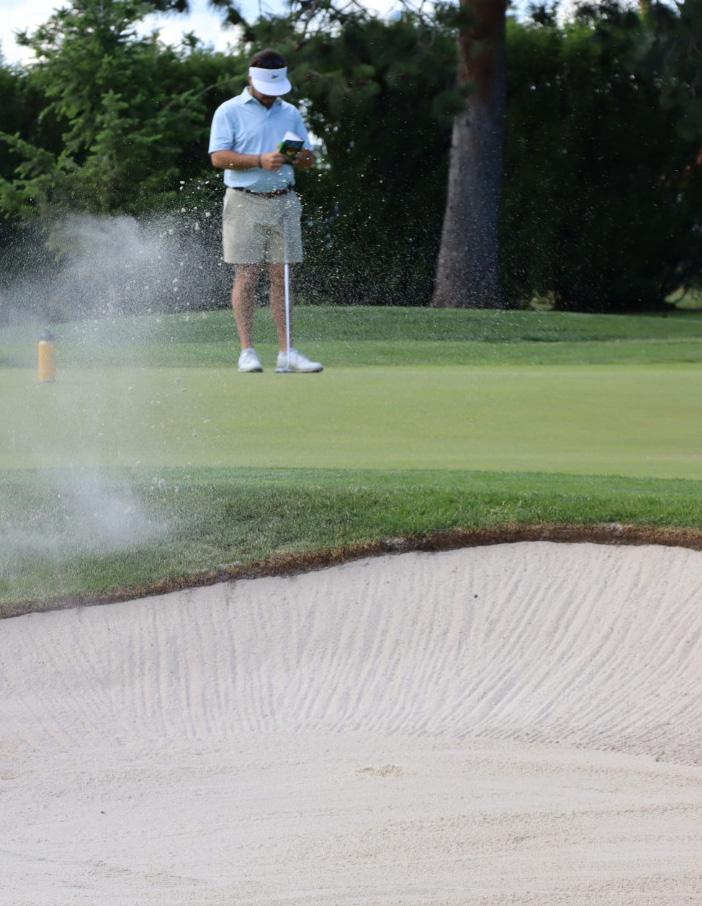
One lingering regret among longtime members is that the additional 47 acres sold during the Depression were never reclaimed—imagining another nine holes matching the charm and quality of today’s course is an enticing thought.
Having served on staff from 1975 until my retirement at the end of last year, I am deeply proud to have been part of Hilands Golf Club’s remarkable legacy—a century of Billings and Montana golf history.

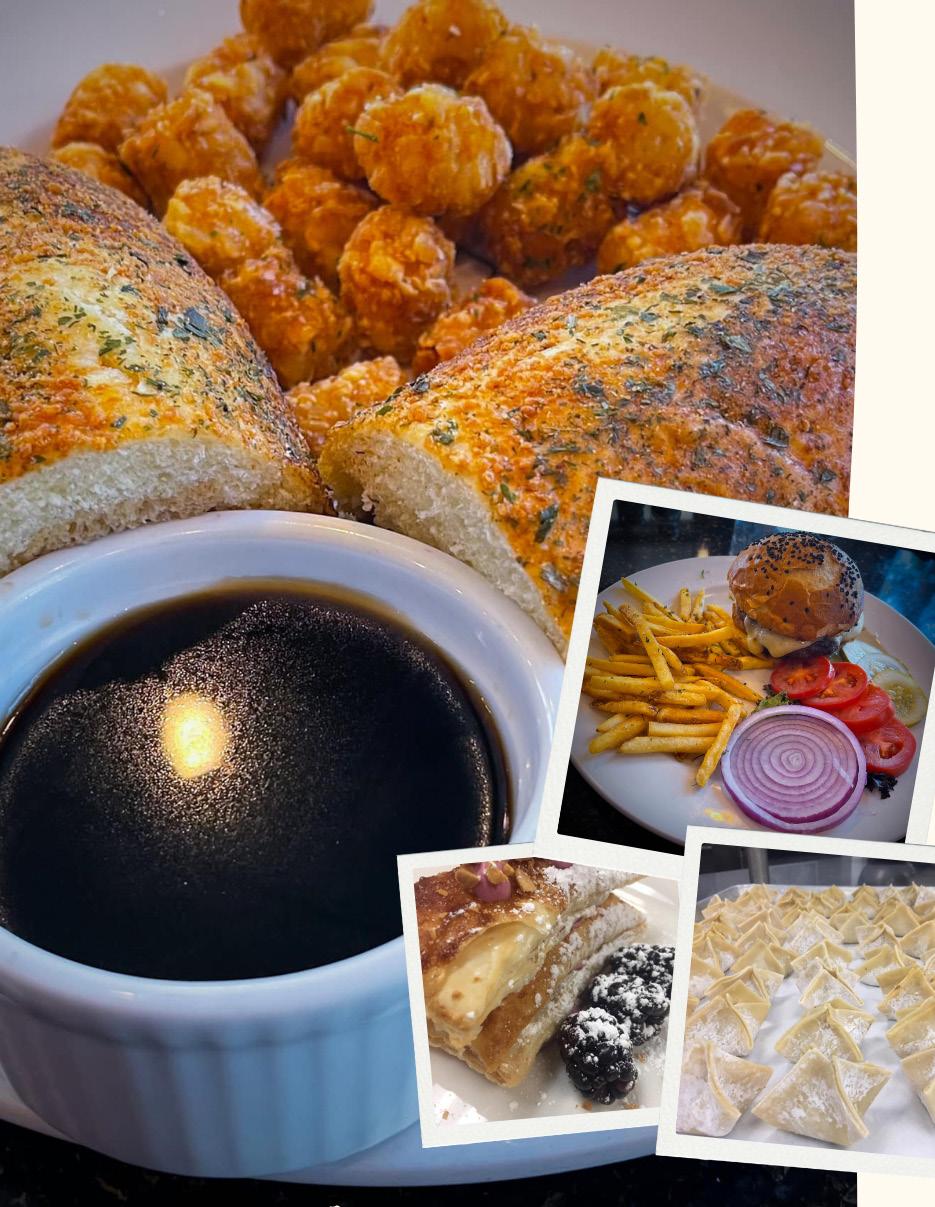

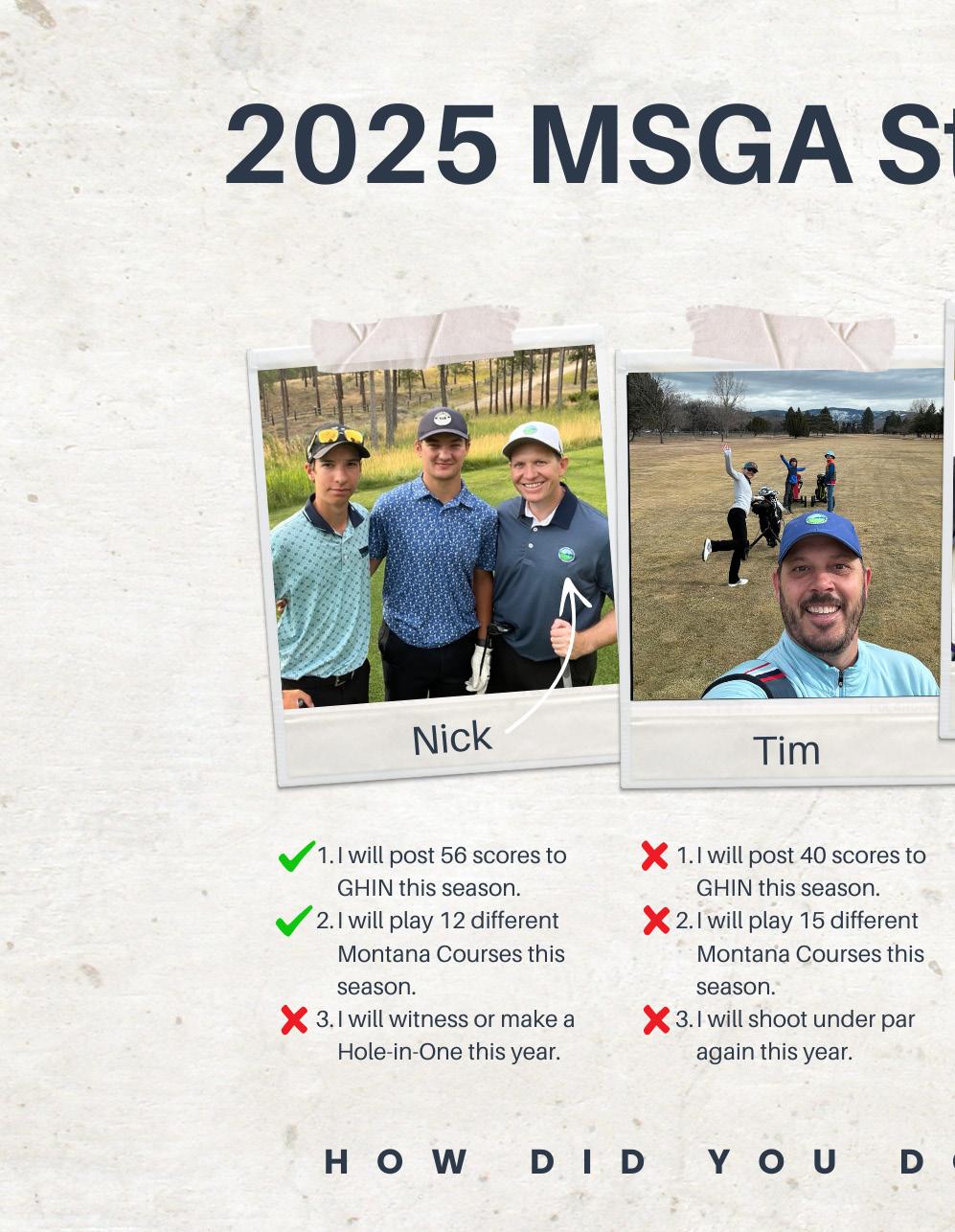




BY TY SPARING MSGA COMMUNICATIONS COORDINATOR
Have you ever found yourself standing in a sand trap and wondered, “why is this here”? I usually ask myself that question after several futile chops at the ball in hopes of getting it back onto some type of green space, before raking the evidence and trying to forget about the experience altogether. I don’t feel too alone with this feeling though because I know well enough that for many people the hazards of a golf course have a way of drawing out an array of emotive questions like “What is that doing there?!?” or “Why me?!?” or the somber “Where did my ball go?”
Nevertheless, even when taking the emotions out of it, bunkers remain a curious feature of the Royal & Ancient pastime. An outside observer without the slightest experience in golf might be forgiven for asking why one of the five defined areas of the course consists of a few dozen large holes filled with plops of sand and scattered throughout an otherwise mostly green playing ground.
Well, as is the case with many of these types of questions, it all goes back to the velvety shores of Scotland where the first links-style courses came to fruition. Lands once used for grazing sheep and cattle, where bored shepherds used herding sticks to hit small stones as they meandered their way through the soft grounds. During times of severe wind and rain the sheep would gather together and hunker beneath mounds which were a common fea-
ture of the rolling terrain, and over time, the green vegetation would erode away, leaving a bare and hollow spot that would fill with sand, blown over from the nearby beaches.
Sometimes those 18th century shepherds would hit their stones into the pits of sand where the sheep gathered, and perhaps like modern golfers they would scratch their heads and wonder how their swing could go so wrong. One thing we do know is that as the game evolved, these little pits of sand were considered critical to the overall golfing experience.
The term “bunker” derives from an old Scottish term “bonkar” which referred to a chest or a box and often considered as a place to sit. In the world of golf, the term made it’s first official appearance in 1812 when folks at St. Andrews wrote down thirteen rules of golf. As Article IV stated: “Stones, bones, or any break-club within a Club-length of the ball may be removed when the ball lies on grass, but nothing can be removed if it lie on sand or in a bunker, if, however, it sticks fast in the ground, it may be loosened.”
(St. Andrews by the way has a notorious sand hazard known as the “Hell Bunker.” At the 1995 Open Championship, Jack Nicklaus famously needed four attempts at getting out of it!)
While certainly known as a hindrance to golfers, (especially if there were bones in there!) by the early 1800s the bunker had long been perceived as vital to a respectable golf course. In fact, as told by the former Director
Old golfing proverb: A house built on sand cannot stand, but a golf ball in a sand trap may remain indefinitely.
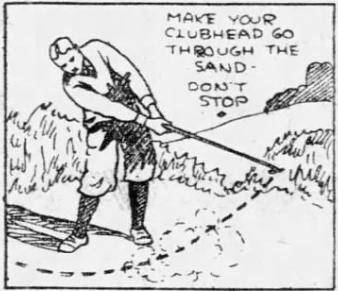
of the British Golf Museum, Peter N. Lewis, in those early going days “the quality of the turf and the nature of the hazards were more important than the number of holes on a course.”
Writing in 1889 in his influential book Hazards in Golf, St. Andrews golfer J.G. McPherson reiterated the long-held tradition that bunkers were “most essential for the interest and fascination of the game.” A couple years later the R&A agreed with McPherson’s assessment and for the first time classified bunkers as an official part of the golf grounds.
As the world moved into the 20th century, like in many other areas of life, industrializa-

tion took hold of the sport, allowing course architects the freedom to calculate locations of bunkers through the use of heavy machinery. “Sand-traps” as Americans started calling them, in fact had become such popular fixtures on golf courses, they began spawning accessory items: Rakes and Sand Wedges.
Along with becoming more selective about their sand-traps, so too did clubs begin the tradition of raking them. While some old-school golfers of the era considered raking bunkers to be “babyizing golf,” most courses encouraged the sportsmanlike gesture in an effort to offer competitors a level playing field. Although,

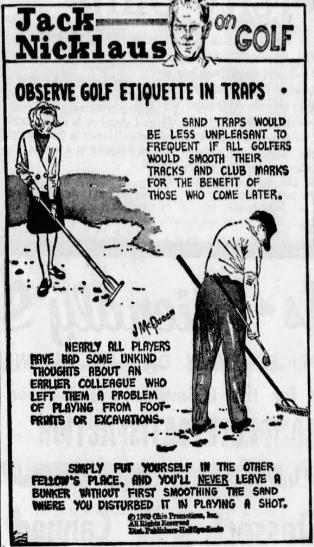
some courses like Oakmont in Pennsylvania viewed raking as yet another creative method to punish wayward golfers.
In 1927, after a miserable performance at the U.S. Open Championship at Oakmont Country Club, Bobby Jones wrote a letter to the editor denouncing the bunkers found at the notoriously challenging course. “The furrows,” he wrote, “had been carefully and diabolically raked in all the bunkers.” Indeed, using a heavy rake nicknamed the “Devil’s Back Scratcher,” the greens crew at Oakmont would create deep grooves in the sand about the width of a golf ball, and all but guaranteed an extra stroke for beach goers, even for play -
ers of Jones’ caliber.
Oakmont Country club, a course that is still infamous for its high-level of difficulty, continued the tradition of furrowing bunkers until the 1960s when the USGA finally had enough and started requiring more properly raked sand-traps. Nevertheless, the “Devil’s Back Scratcher” is still proudly displayed at Oakmont.
Sand Wedges on the other hand also earned a little bit of notoriety when they were introduced in the early 20th century. They had become very fashionable by the early 1930s, but due to what was considered an unfair concave-faced design, the USGA barred them in 1931 from tournament competitions.
Not to be too discouraged, Gene Sarazen fashioned a new type of sand wedge that came within the legal requirements set forth by the USGA and proceeded to win both the 1932 Open and U.S. Open Championships. Having proved effective on such a large stage, Sarazen’s sand wedge immediately became a must-have in every golfer’s bag and is still the template for what we use today.
Not everybody loved all the newfangled developments however, particularly some of the old guard who were never given such advantages when they were coming up. When asked in 1939 about how he and Bobby Jones would hold up against the then current crop of golfing stars, Walter Hagen didn’t mince words on how much easier the game had become for the younger players. “Sure, they’re shooting a little better average scores than Bobby and I did in our prime,” he opined, “but that doesn’t mean anything, this sand wedge they’re using now is enough to account for the difference by itself, not to mention that the modern ball rolls 30 or 40 yards further.”
*Hagen, by the way, was known to use a putter to get himself out of sand traps*
The “industrialized” bunker that characterized mid-20th century golf began to wane by the 1980s, as golf architects began reimag-
ining the former “naturalist” look that came before heavy machinery squared everything off. The creative designs of early century architects like Donald Ross and Alistair MacKenzie were en vogue once again and looked to for inspiration as designers started breaking away from the homogenized sand-traps that defined previous decades.
As Tony Dear writes for Links Magazine, this is more-or-less where we’re still at today. “The irregular, contoured, sand-faced, wind-eroded look that Doak rekindled in the late 1980s, Coore & Crenshaw made popular in the mid-’90s and ’00s, and which Gil Hanse, Mike DeVries, David McLay Kidd, Rod Whitman, Dave Axland, and others have all now perfected, has been trending for quite a while.” Who knows what the next trend in bunkers will be?
In 2019 the USGA and R&A ruled that bunkers were one of the five defined areas of the course (including General Area, Teeing

Area, Penalty Area, and Putting Green). It’s a big business too, as the USGA wrote in 2025, bunkers are actually the priciest part of a golf course to maintain. With so much focus put on sand-traps, for some golf courses it’s the first thing people think about. Old Works being one such example, with the black slag bunkers harkening back to Anaconda’s mining days.
Things have certainly come a long way for the humble golfing hazard. A place where sheep once huddled to escape the wind and rain of northeast Scotland became a fundamental part of one of the most popular sports in the world. Nowadays the holes are designed with artists’ precision, dug with modern machinery, filled with the finest sands around, and gently groomed after each shot. While it might be hard to appreciate the sand hazard in the moment, when you think about why you love a particular golf course, don’t forget about the bunkers.


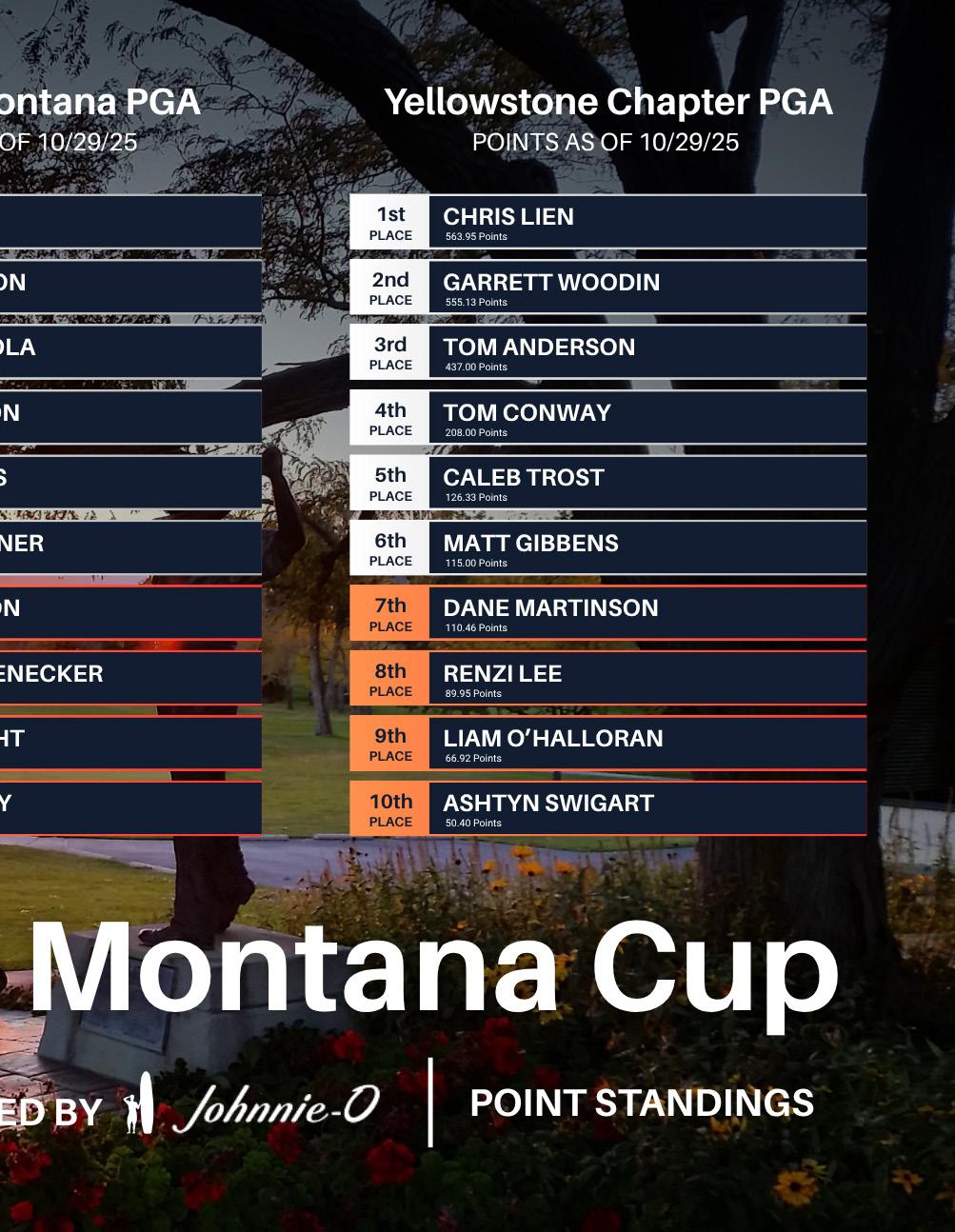

4. What is your favorite course in Mon tana and why?
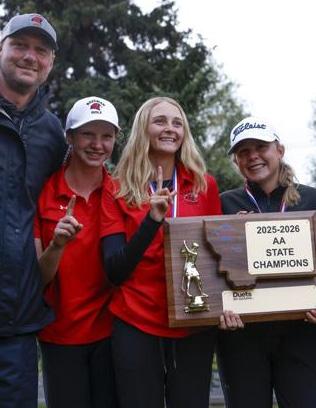
1. Who introduced you to golf?
I was a late start when it comes to golf. In my late 20’s my friends started bringing me along to golf at Cottonwood hills in Bozeman. It’s been a great activity to do with friends.
2. Who influenced you most in your golf life?
My childhood friend Ben Fisher, Gallatin golf coach Matt Clark and former Coach Matt Barefield and my JV coach Todd Houston.
3. What was it like winning the 2025 Class AA team championship with the Bozeman High girls’ team? What makes this year’s team so special?
I was just so happy for them. They’ve been so consistent all year and to watch them win it in the end was pretty special. We were fortunate enough to have 3 senior girls who all finished in the top 5 at state. They’ve been golfing together and mostly on varsity all four of their years. They are great role models for future female golfers and have a great mindset for golf.
Rising Sun was pretty darn cool to be able to play once. It’s located where I used to work at Mountain sky and the scenery is awesome.
5. What is a dream golf course you’d like to play once?
Either Pebble Beach because my Grandpa played there once or The Stock Farm.
6. What is your dream celebrity foursome (living or dead)? Why would you choose them?
My Grandpa was apparently a very good golfer in the 40’s and 50’s so I would choose him and he could choose two of his friends to golf with us. It would be pretty cool to go back in time and experience that.
7. What’s your most memorable moment on a golf course?
I would say watching the 2020 or 2025 girls team win state. Both teams had awesome seniors.
My golf game is pretty mediocre so not a lot of awesome memories. Ha
8. If you could change one thing about the game of golf what would it be?
Eliminate stroke and distance penalty on lost balls and OB. Unlimited clubs in the bag and more accessible to all.
9. What advice would you give to beginner golfers?
To try and relax and have fun out there.

Try to learn from mistakes but don’t dwell on them. Realize that you aren’t a pro golfer and focus on being positive with yourself.
Bonus: Lay up or go for it?
Most of my players lay up, but I may as well go for it. What do I have to lose!
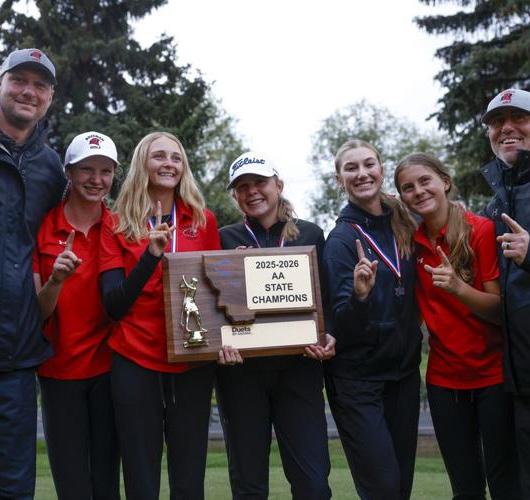



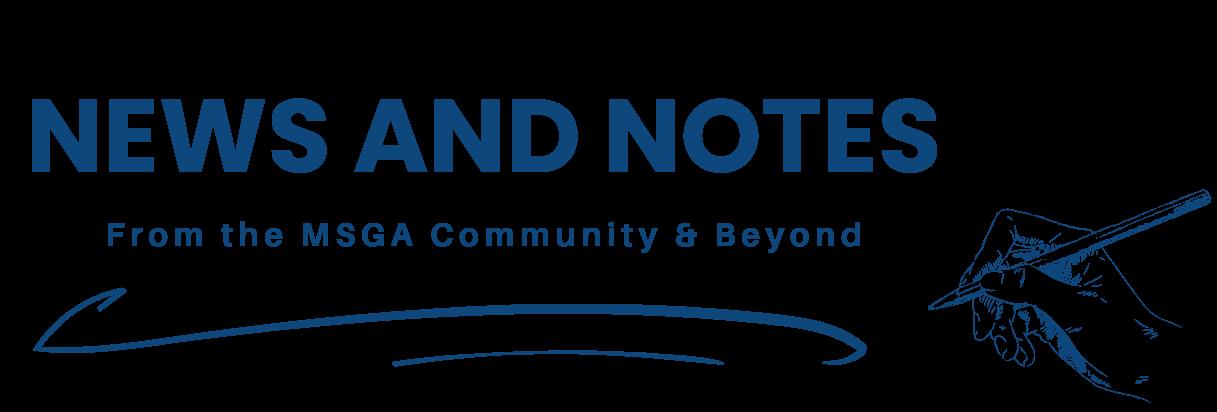
Kalispell golf pro, Ryan Malby, was recently at the Willamette Valley Country Club for the 34th annual Senior Hudson Cup. Showcasing some of the best golfers in the Pacific Northwest, Malby was part of a contingent of ten PGA Professionals that faced off against ten elite amateurs in a Ryder Cup style format.
The professionals managed to take the victory 11 to 9, with Malby winning his second-round foursome matchup where he was paired up with Spokane’s Darin Vaughan.

Named after, Portland Businessman and avid golfer, Robert A. Hudson, the original Hudson Cup goes back 77 years, named for the man who helped keep the PGA Tour alive during the World War 2 years by acting as one of the few sponsors that could actually provide support. Hudson would later go on to become the first chairman of the PGA Advisory Committee.
For full results of the Hudson Cup, CLICK HERE
A few weeks ago golfers in Billings had a new type of hazard roll through the course, one that they hope never to see again.
After an armed robbery took place at the Rimrock Mall, police chased the suspect through several neighborhoods before the suspect plowed through a fence at Yegen Golf Course and made his way through the driving range before eventually being apprehended later on, away from the course. Although there was a little bit of damage done to the property, thankfully no one was injured.
After a short spell back home in Libby in which he snagged his first archery elk, Ryggs Johnston headed back to Spain where his DP
World Tour adventure began a year ago. It was there he finished his final stages of Qualifying School, earning his Tour Card and going on to compete against the very best of the best at some of the most prestigious courses in the world.
Competing at the Open de España at Club de Campo Villa de Madrid, Johnston ended up in the money once again with a 55th place finish. Ending up at even par after four rounds, Johnston was powered by a second round of -2 (69) where he accumulated six birdies. For his

efforts he earned just under $12,000.
For Ryggs it caps off an incredible first season on the DP World Tour that included an exciting early win at the Australian Open and making the cut at the 153rd Open Championship. While just missing the cut by two spots (72nd overall) to get into the DP World Tour Final Playoff, Johnston is nevertheless a player to watch next year on tour as he continues to grow and develop his game in the years to come.


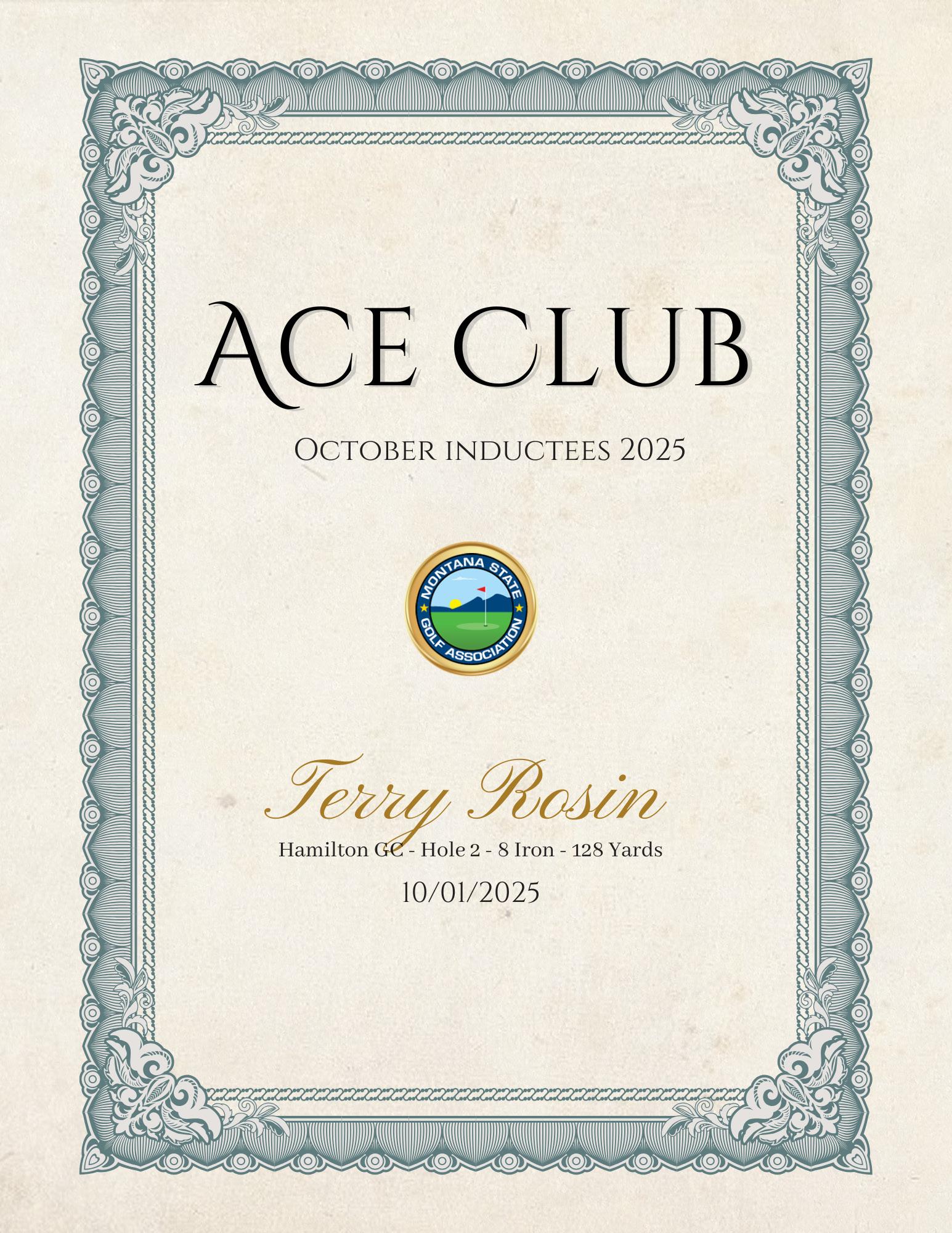
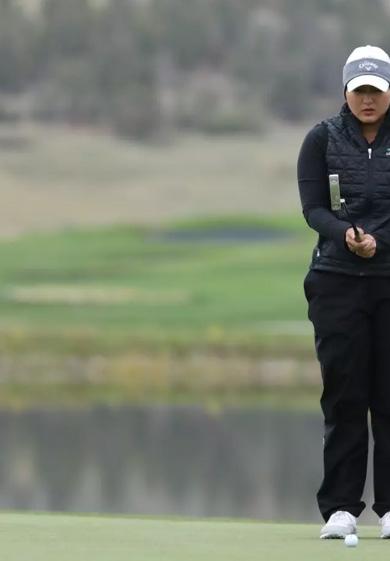

BY TY SPARING MSGA COMMUNICATIONS COORDINATOR
The MSU-Billings men’s and women’s golf teams finished off their fall portion of the season at home under snowy conditions at The Briarwood Golf Club. Despite the frigid conditions competitors were still able to get

both rounds completed, with both Yellowjackets teams ending the fall on high notes.
On the women’s side Orraya Tipasathien continued her GNAC dominance, collecting her seventh collegiate victory with a final score of +3 (147). For the junior from Thailand, every win extends her program record and no doubt there will be more to come. With the final half of her junior season next spring, and assuming she stays next year, Tipasathien might very well put every female MSU-B record out of reach for a very long time.
The Yellowjacket women won as a team by 36 strokes with a final total score of +50 (626). Along with Tipasathien, MSU-B had five other golfers in the top ten, including Ella Tannenberger who finished up in second place at +9 (153). In sixth place was Hannah Adams at +20 (164), in seventh was Kyleigh McGowen at +21 (165), Haylee Adams finished up in a tie for eighth at +8 (166) and freshman Hanna Boyd rounded out the top ten with a tenth-place finish at +23 (167).
Montana golf fans might’ve noticed another familiar face in the top ten, as former Gallatin High All-State golfer, Addiley Lloyd, finished in a tie for fourth place while competing for South Dakota Mines.
For full women’s results, CLICK HERE
The boys’ team meanwhile finished in second place by five strokes with a final

two round score of +17 (593). Kaopun Akmaneenin led the way for MSU-B with a third place finish at +2 (146). Teammate Peyton Toney followed suit in fourth place with a final score of +3 (147), Aubrey Kelley finished in a tie for fifth place at +4 (148), and Bowdie Fox, Payton Black and Pete Netrnilweerachot all tied for ninth place at +5 (149).
For full men’s results, CLICK HERE
The Bobcat golf team finished off the fall portion of their season at the Dale
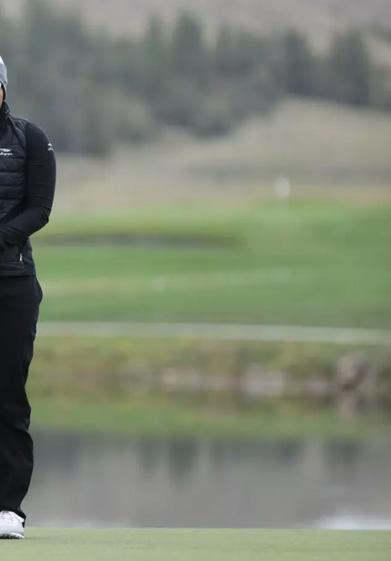
McNamara Invitational in Broken Arrow, Oklahoma. Held October 13-14 at the Cedar Ridge Country Club, MSU had their hands full against a litany of top tier D1 golf teams over the course of three rounds.
As a team MSU finished in fourteenth place at +52 (904). They were led by two-time Montana State Amateur champion, Lauren Greeny, who finished up in a tie for 42nd place at +12 (225) and freshman Sailer Graham who finished in a tie for 48th place at +13 (226).
Arkansas won the team event at -11 (841) while Oklahoma’s Savannah Barber took home the individual honors with a final score of -11 (202).
After another record-breaking fall season, the Bobcats will go into winter hibernation
for a bit before returning to the course in February for the Mountain Classic Match Play event in Palm Desert, California.
For full results of the Dale McNamara Invitational, CLICK HERE
The Rocky Mountain College men’s and women’s teams continued their dominance in the fall portion of the season recently at the Battle at the Dance in Windsor, Colorado. Coming into the event with both teams ranked 15th nationally, the Battlin’ Bears once again swept both team and individual titles at Raindance National Resort and Golf.
Playing two rounds, the women’s team took victory with a score of +53 (629). Kadence Fischer led the team with a first-place
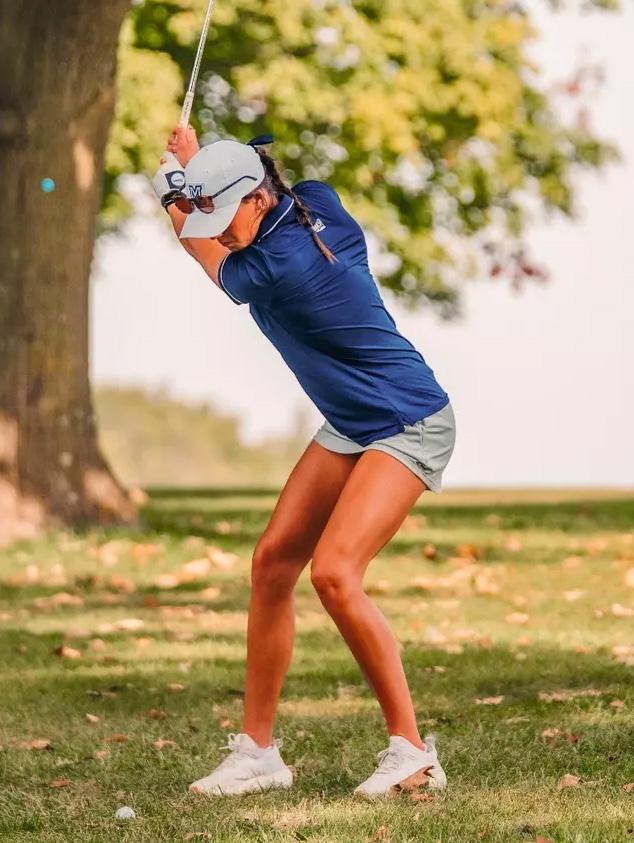
finish at +8 (152). Fischer, who is a former Billings West golfer, caught fire in the second round, posting the only score under par in the whole tournament. With four birdies over the round, Fischer made up a seven-stroke deficit as she vaulted her way to the top of the podium during the second and final day.
Joining Fischer in the top ten was Grace Metcalf who ended up in second place at +9 (153), Tyla Potgieter finished in sixth place at +15 (159), and Kirsten Smith landed in eighth place with a final two round score of +21 (165).
On the men’s side Rocky won the team event by eight strokes with a final threeround score of +22 (886). Ending up at -5 (211), Jared Smith posted the only score under par for the tournament, by six strokes over teammate Kristjan Burkelca.
For full results of the Battle at the Dance, CLICK HERE
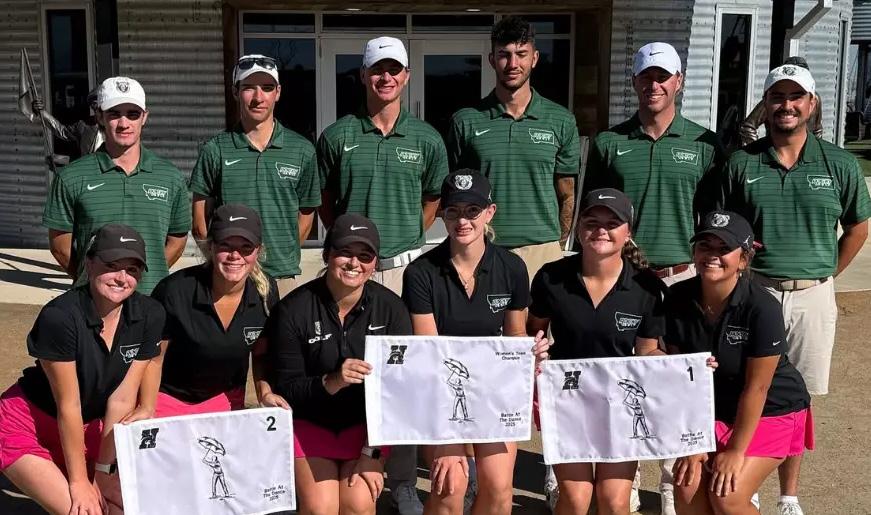

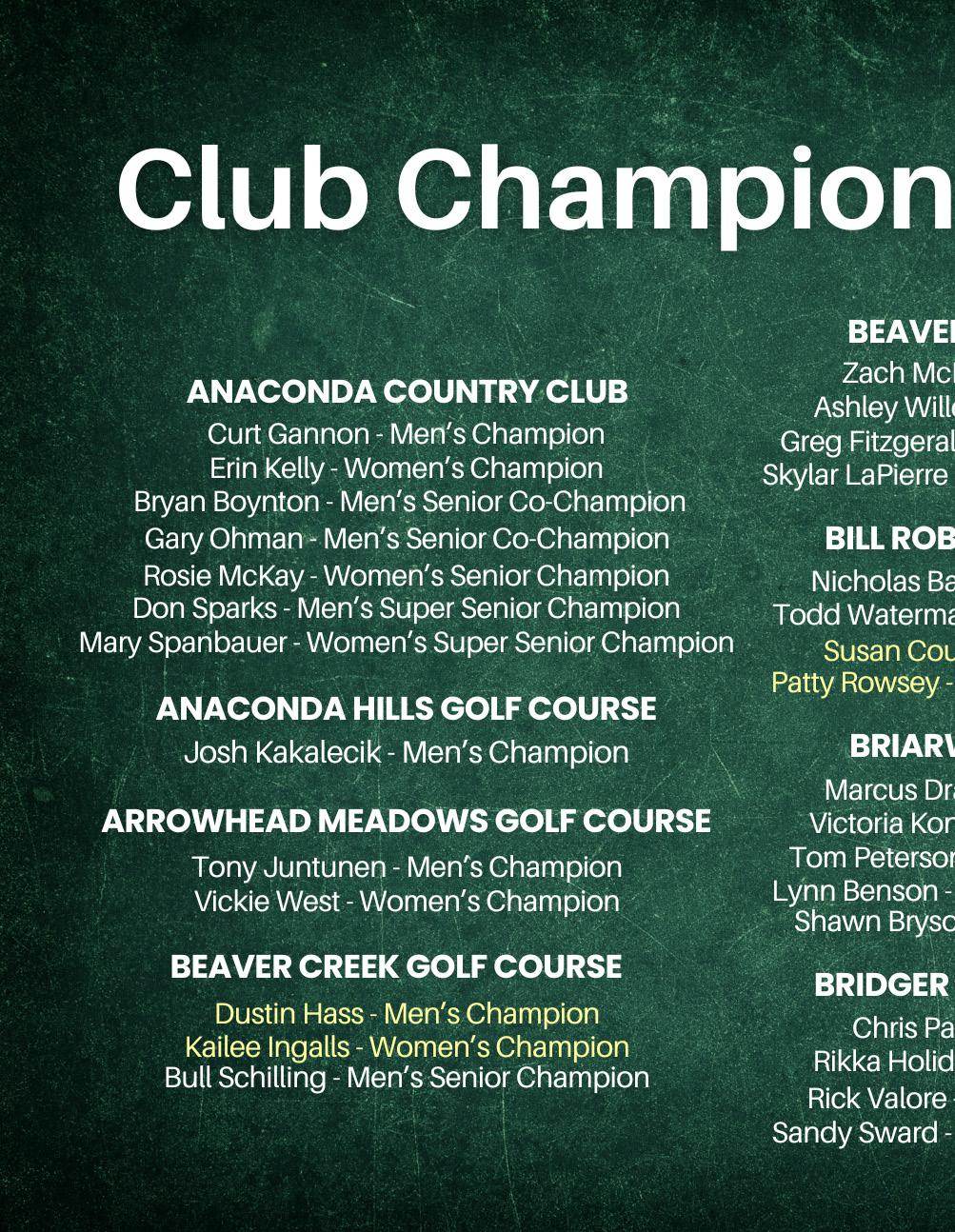
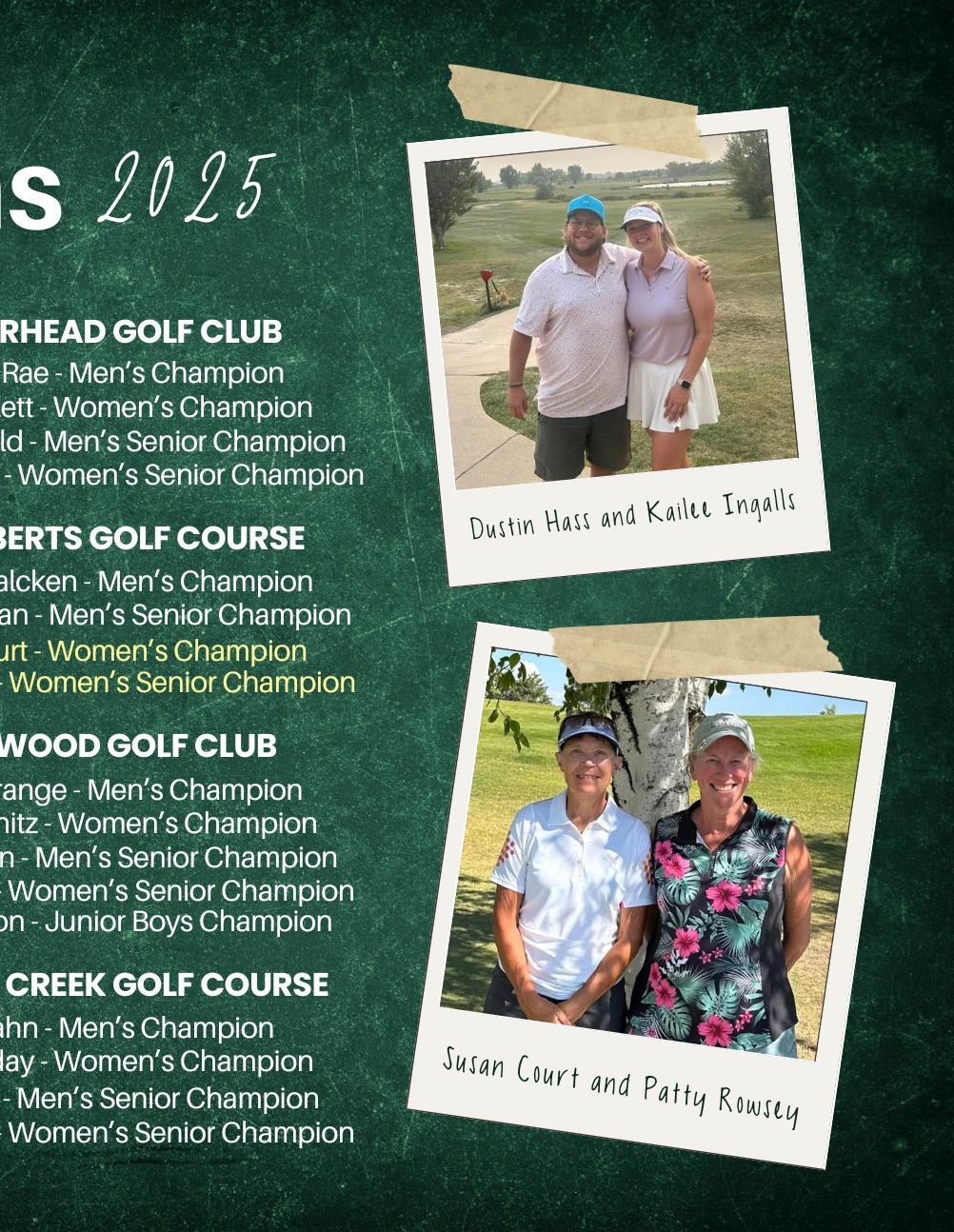
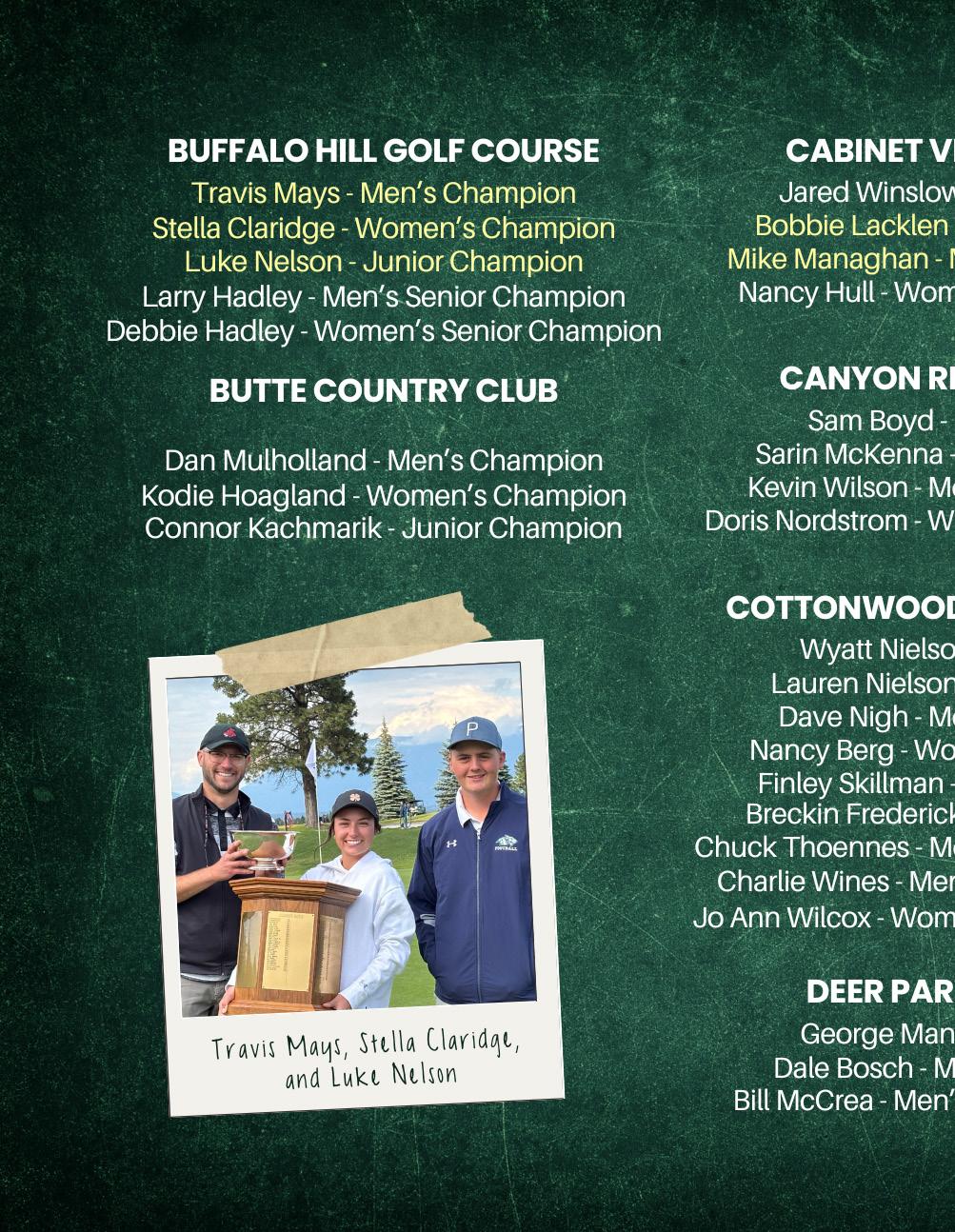


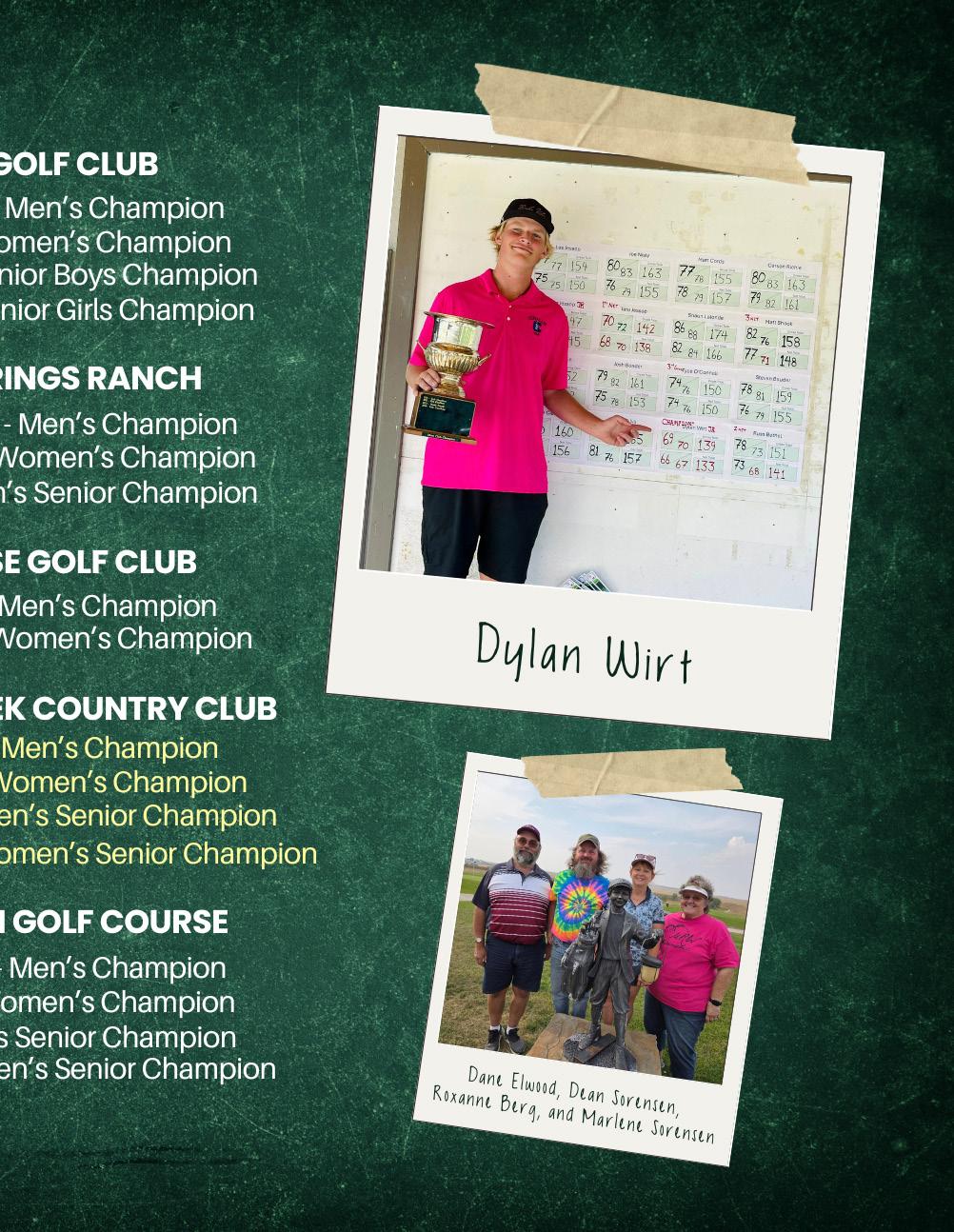
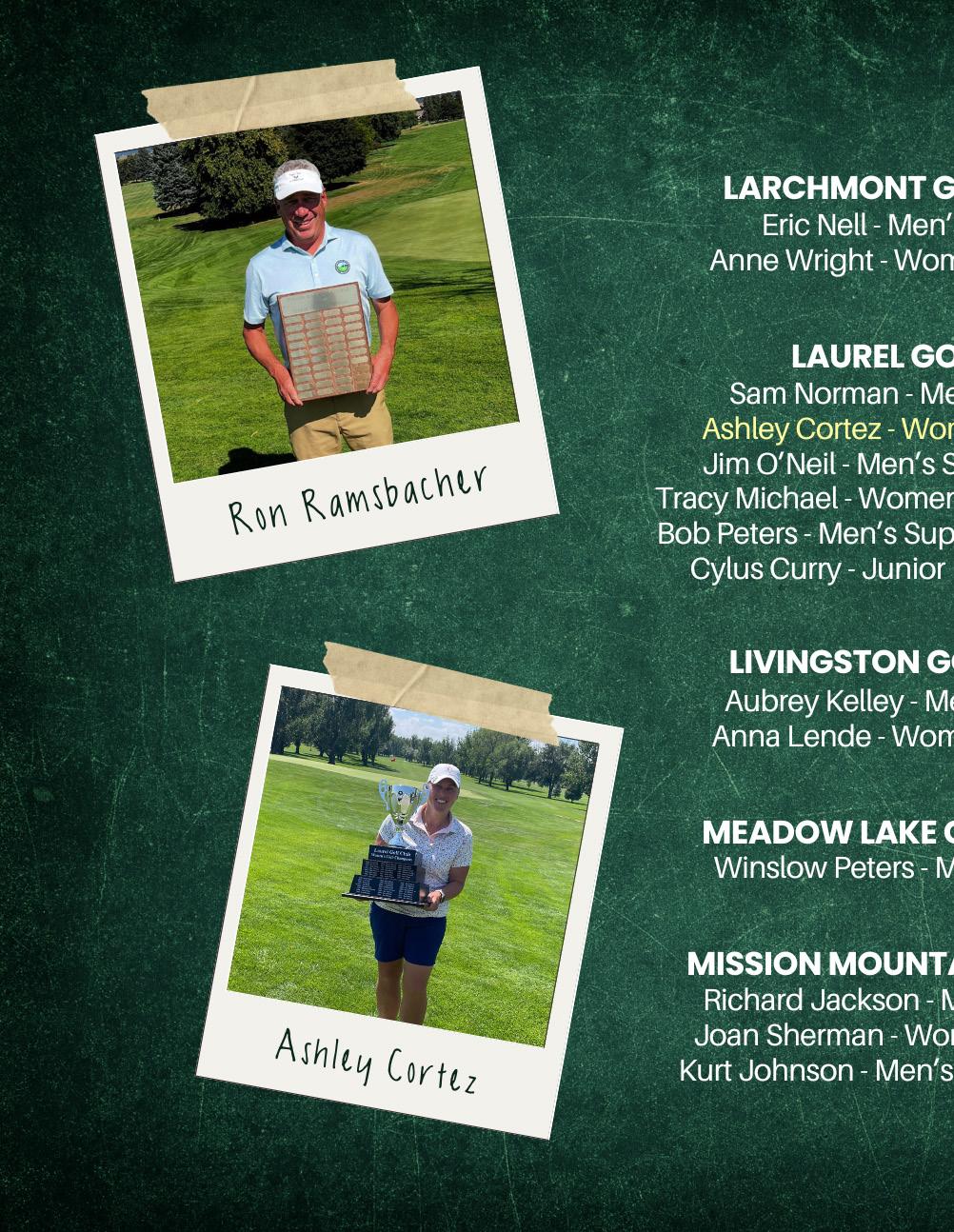

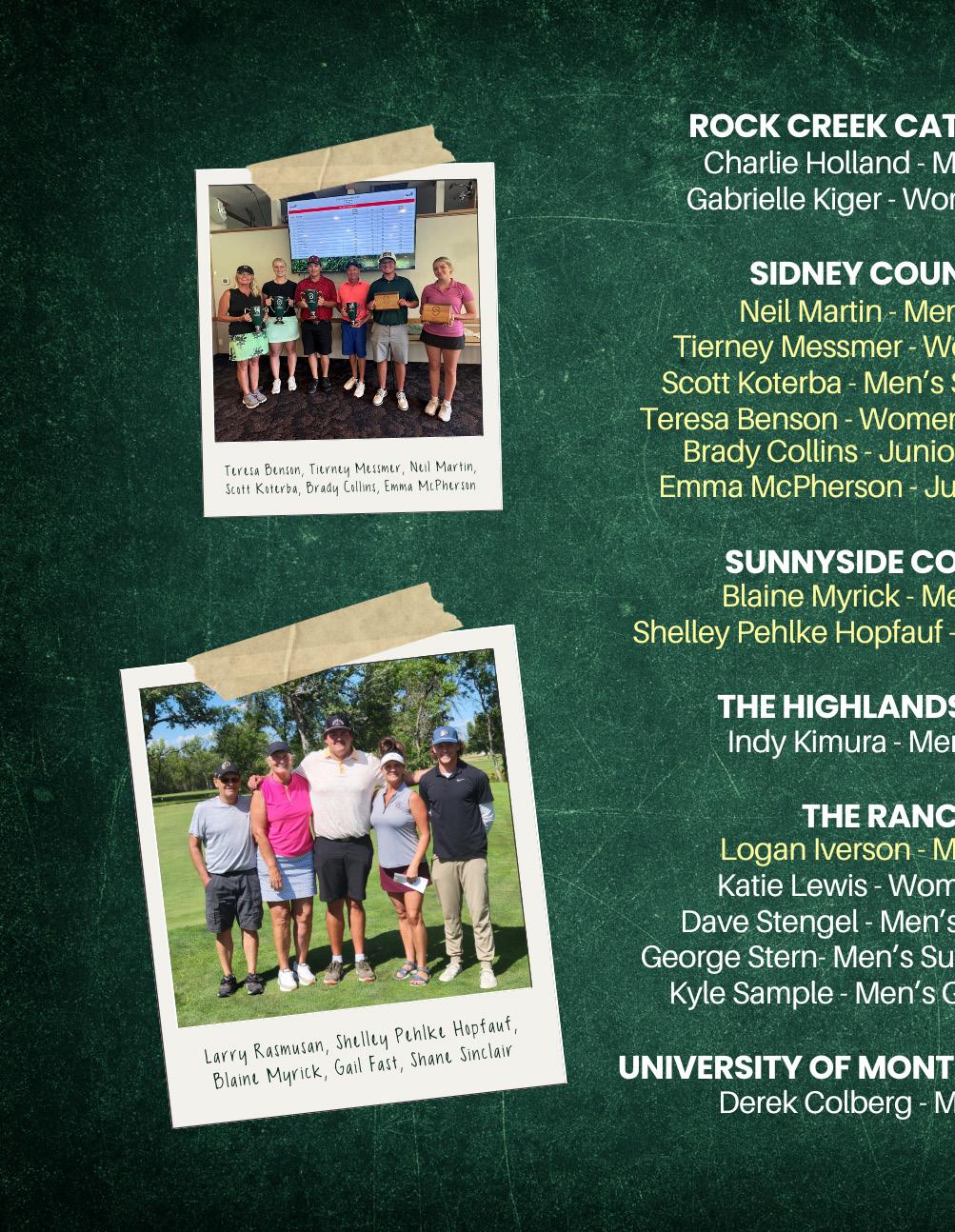
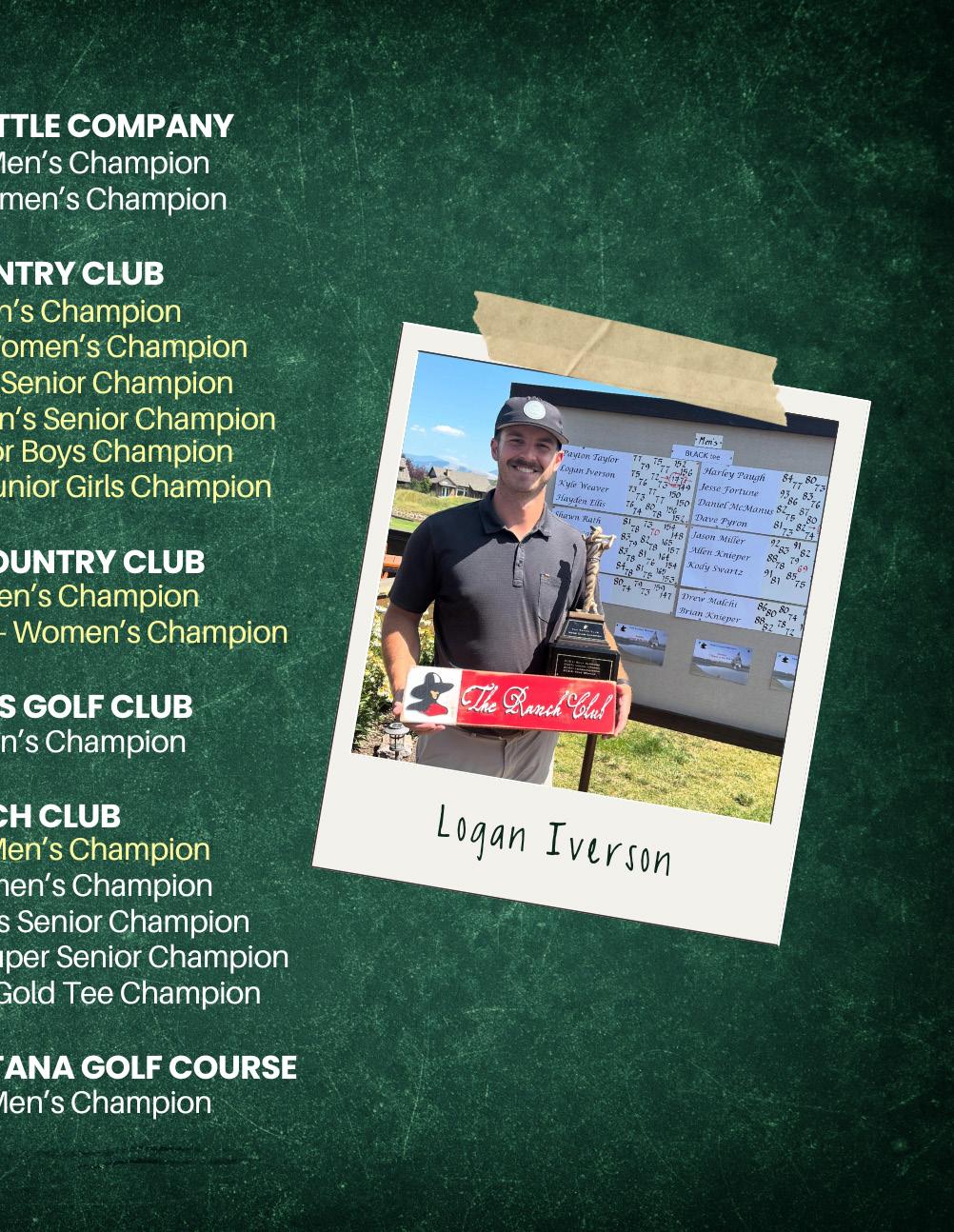
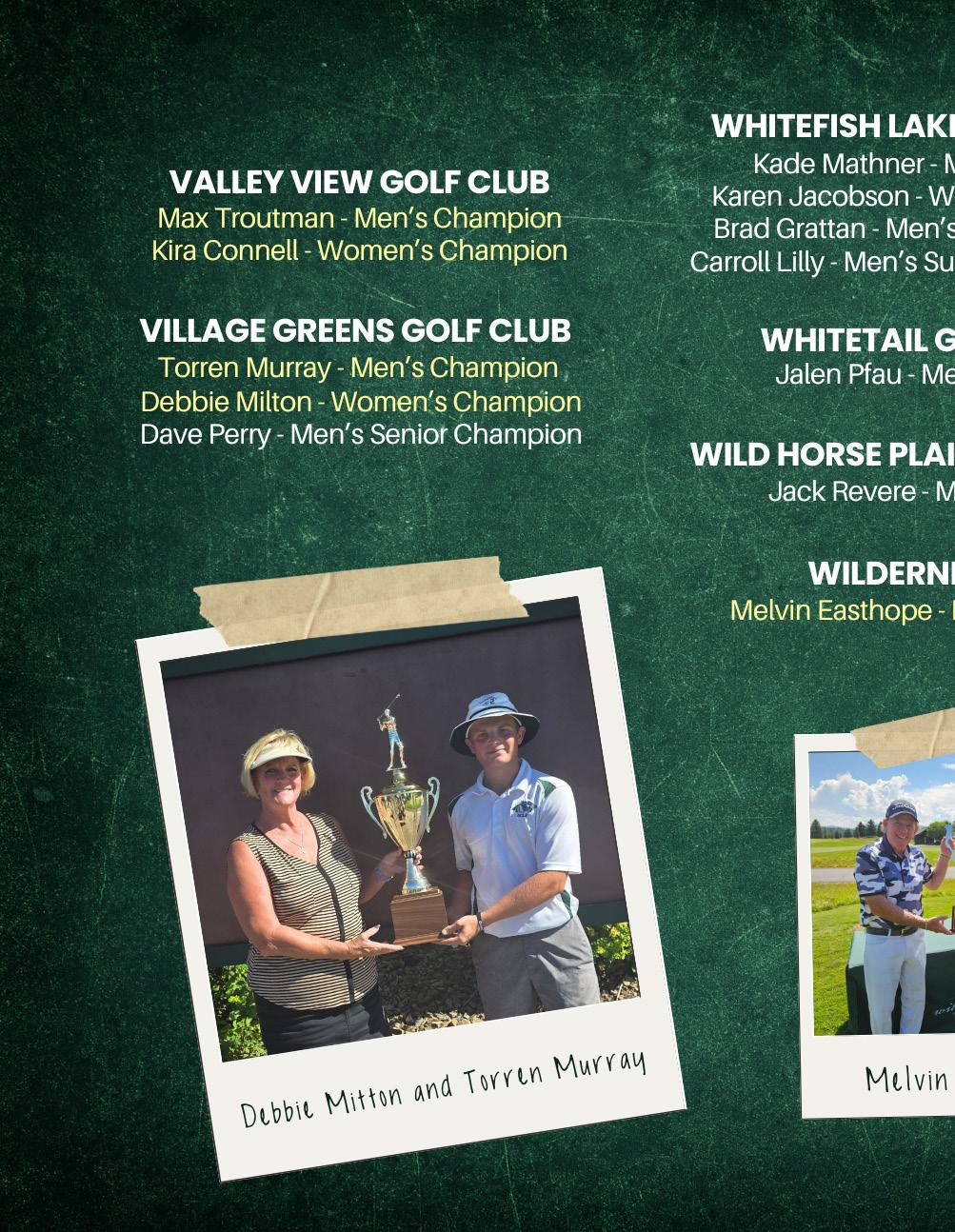






BY CONNOR DEBRUYCKER SUPERINTENDENT AT SIGNAL POINT GOLF CLUB
There are many people who have helped get me to the position I am in today. I have had the privilege of working under some great superintendents and assistants during my first ten years in the turf industry.
I worked at Signal Point Golf Club in Fort Benton during high school and Bridger Creek Golf Course for three years while I was going to college in Bozeman. I learned a lot while working for Cameron Tuss and Dane Gamble, not only about turf but more importantly, how to manage a staff. I watched them manage and have tried to implement some of those same strategies once I became a superintendent. They both treated their staff with respect and cared about each member of the crew.
Dane would take any opportunity he could to teach you something new and explain why it was important. He made each member of the crew feel like their work was important and appreciated. You felt more like a family than you did a grounds maintenance team. Having that close bond as a crew helped keep everyone engaged and accountable. It was amazing how much work could be done when the whole team worked together. Both Cameron and Dane led by example, by showing you the right way to do things.
When you see your boss doing all the small things like picking up stray garbage or fixing ball marks on the greens, it makes you want to work that much harder for them. I can remember when I worked at Bridger Creek, we had to dig out a drainage ditch in the mud so some water could drain to a nearby pond. I would understand if they just sent out one of the new crew members to go perform a glamorous task
like this. Instead, Wes Easton, the assistant superintendent, joined me and one other guy to dig this 30-foot trench in the marsh.
It might not have seemed like a big deal at the time, but I often reflect back on that day. I knew if I became a superintendent that I would want to lead with that same mentality — that even the worst or most difficult tasks on a golf course, the boss was willing to perform themselves. Your staff is looking to you to set an example, and your actions can make lasting impressions. I had the privilege of working under some great mentors before I took my first job as superintendent at Signal Point. Each one of them taught me a different aspect of golf course maintenance. But most importantly, I learned how to be a leader. I was able to see firsthand how a superintendent should treat their staff, and how a staff responds to good leadership.
Below is a picture of the most important member of the grounds crew at Signal Point. Bubba is a three-year-old English Bulldog who helps to keep the crew in good spirits throughout the summer. Her afternoons are busy, spent chasing deer and geese off the course.
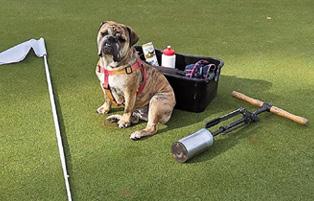
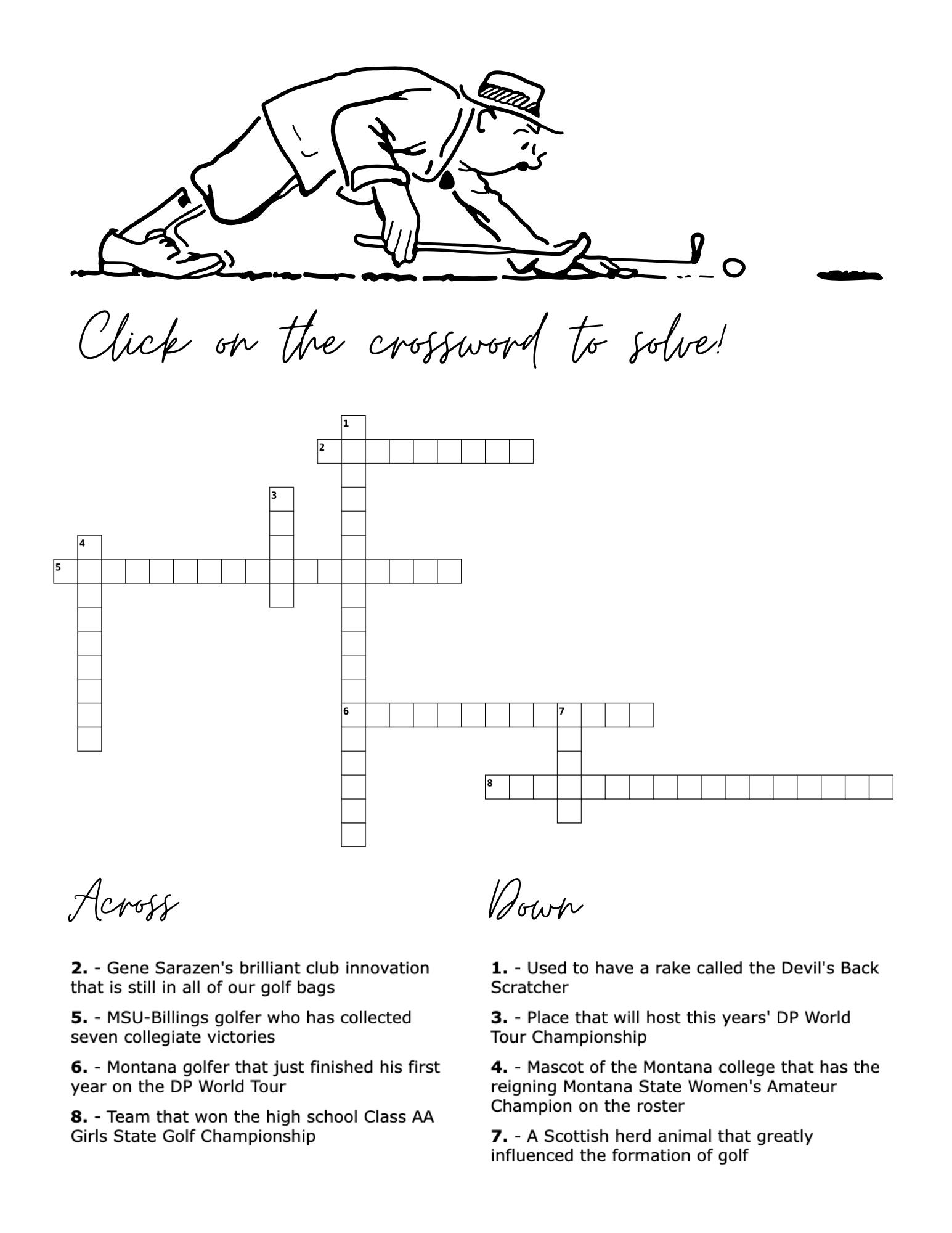


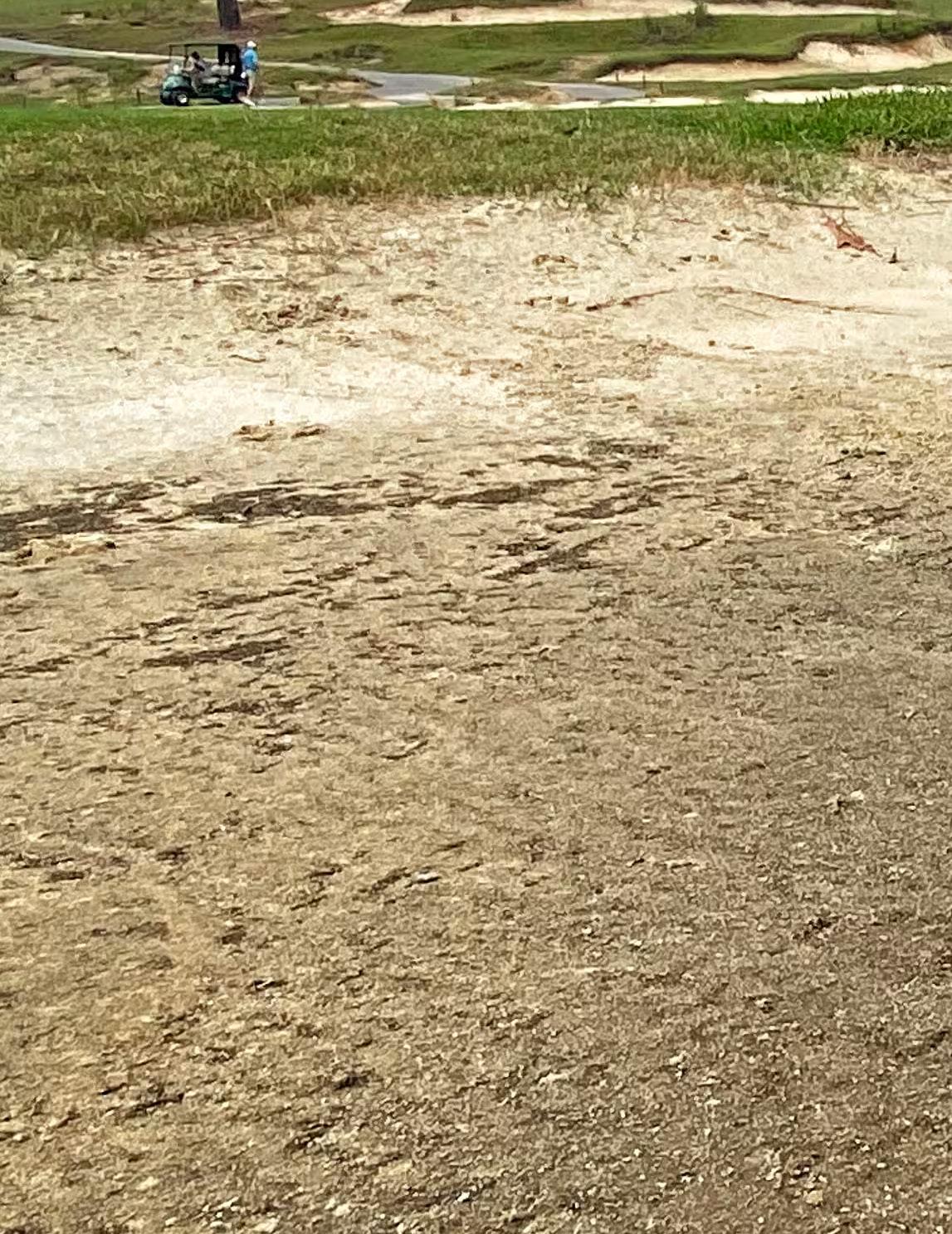

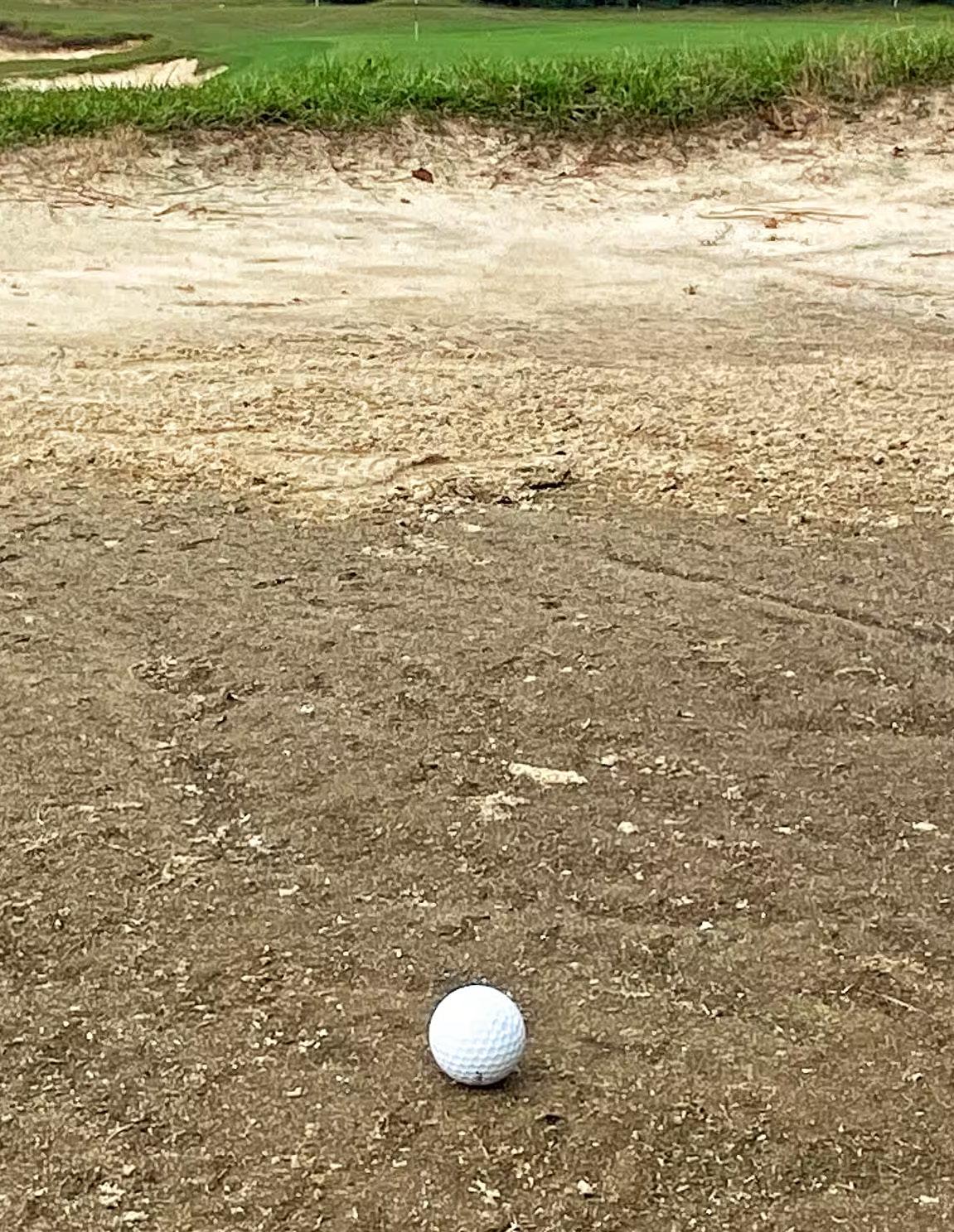
er sand can become excessively soft when dry, leading to fried-egg lies. This is a good time to remind everyone that bunkers are never perfect, nor should they be! One of the best quotes on this subject came from none other than Old Tom Morris: “Bunkers are not meant to be places of pleasure, they are prisons for punishment and repentance.”
Courses can fluff up overly firm sand with aggressive raking techniques, but this only temporarily softens it. The bunkers will soon revert back to firm conditions, especially with highly contaminated sand. Something needs to change to keep the sand from becoming firm again. That could be periodic rototilling,
which can be necessary every month for extremely firm sand. If firm conditions persist, it is time to replace the sand. Typically, it is recommended to replace bunker sand about every 10 years.
If you find yourself in a greenside bunker that has compacted sand, dig in and make the best of a difficult shot that is a direct result of your previous errant shot. You can certainly let the golf shop know about the firm conditions, but as former PGA Tour player Graham DeLaet eloquently said: “Everyone is going to make bogeys and doubles and get bad breaks in bunkers. It's just kind of licking your wounds and taking what it gives you and move on.”
